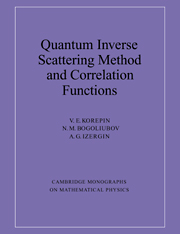Book contents
- Frontmatter
- Contents
- Preface
- Part I The Coordinate Bethe Ansatz
- Part II The Quantum Inverse Scattering Method
- Introduction to Part II
- V The Classical r-matrix
- VI The Quantum Inverse Scattering Method
- VII The Algebraic Bethe Ansatz
- VIII Lattice Integrable Models of Quantum Field Theory
- Part III The Determinant Representation for Quantum Correlation Functions
- Part IV Differential Equations for Quantum Correlation Functions
- Final Conclusion
- References
- Index
V - The Classical r-matrix
Published online by Cambridge University Press: 04 August 2010
- Frontmatter
- Contents
- Preface
- Part I The Coordinate Bethe Ansatz
- Part II The Quantum Inverse Scattering Method
- Introduction to Part II
- V The Classical r-matrix
- VI The Quantum Inverse Scattering Method
- VII The Algebraic Bethe Ansatz
- VIII Lattice Integrable Models of Quantum Field Theory
- Part III The Determinant Representation for Quantum Correlation Functions
- Part IV Differential Equations for Quantum Correlation Functions
- Final Conclusion
- References
- Index
Summary
Introduction
The modern way to solve partial differential equations is called the classical inverse scattering method. (One can think of it as a nonlinear generalization of the Fourier transform.)
Nowadays, the classical inverse scattering method (CISM) is a well developed branch of mathematical physics (see Preface references. In this chapter, we shall give only the information necessary for the quantization which will be performed in the next chapter. The concepts of the Lax representation, the transition matrix and the trace identities are stated in section 1. Classical completely integrable partial differential equations will appear once more in this book. In Chapters XIV and XV we shall derive them for quantum correlation functions. In those chapters we shall study completely integrable differential equations from a different point of view. We shall apply the Riemann-Hilbert problem in order to evaluate the asymptotics. The classical r-matrix, which enables calculation of the Poisson brackets between matrix elements of the transition matrix (and also construction of the action-angle variables) is introduced in section 2. As explained there, the existence of the r-matrix guarantees the existence of the Lax representation. The r-matrix satisfies a certain bilinear relation (the classical Yang-Baxter relation). The existence of the r-matrix also guarantees the existence of an infinite number of conservation laws which restrict in an essential way the dynamics of the system. In the next chapter, the notion of the r-matrix will be generalized to the quantum case. In the first two sections of this chapter, general statements are demonstrated by example using the nonlinear Schrödinger equation which is the simplest dynamical model (it should be mentioned that in the classical case this name is more natural than the one-dimensional Bose gas).
- Type
- Chapter
- Information
- Quantum Inverse Scattering Method and Correlation Functions , pp. 99 - 114Publisher: Cambridge University PressPrint publication year: 1993



